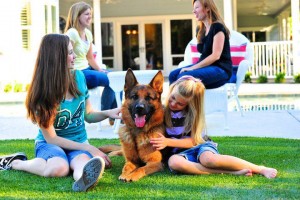Dogs and Kids: Focus on Child Safety
Dogs are an integral part of American culture, with an estimated 40% of households owning at least one dog. Millions of children grow up with a dog as part of their family; this can provide many opportunities for helping children develop empathy, responsibility, self-confidence, positive relationships, and self-esteem1.
However, children also make up the most ‘at-risk’ group for dog bites. Every year an estimated 400,000 children are bitten by dogs2, with the vast majority being bitten by dogs they know. Many people mistakenly assume that any well-socialized, well-trained, friendly dog will never bite someone; the truth is that ANY dog is capable of biting a person under the right circumstances, regardless of training and temperament. Every dog has a variety of triggers (such as stress, pain, and surprise) that can combine to create a recipe for a dog bite.
Well-trained and well-socialized dogs like our family protection dogs may be less inclined than others to bite indiscriminately; however, it is still very important to teach children how to be safe around dogs, even if they do not have a family dog of their own. Never leave any dog-child interactions up to chance; we must be proactive in promoting safe behaviors and interactions between children and dogs.
Suggestions to Promote Child/Dog Safety
1. Never leave young children alone and unattended with a dog, no matter how trustworthy the dog is. The majority of dog bites occur when the child and dog were left alone unsupervised.
2. ALWAYS supervise play sessions between children and dogs. It is your responsibility to watch for signs that the dog is getting overstimulated (very common with young dogs) or tired, and to then end the play session. Additionally, always monitor the children’s games with the dog to ensure appropriate child-dog interactions.
3. Do teach children how to behave properly around dogs:
- Avoid screaming, running, or flailing wildly.
- Avoid hugging the dog or grabbing his face to kiss it.
- Avoid leaning over the dog, as many dogs find this threatening.
4. Do encourage children to properly greet dogs:
- Always calmly approach a dog and ASK the owner for permission before petting him.
- Allow the dog to sniff and greet you first BEFORE reaching out to pet her.
- Avoid patting the dog on the top of the head. Instead, most dogs enjoy a good back scratch UNLESS the owner says otherwise.
- Do not try to hug or kiss the dog. Many dogs resent this close invasion of their personal space.
5. Do teach children about the common warning signs dogs offer that indicate they do not want to be touched. Such signs include:
-
direct eye contact with a hard stare
-
a still and stiff body
-
curled or lifted lip that shows the dog’s canine teeth
-
a hard “whale eye” look coupled with tight, tense lips (a bite is imminent!)
6. Do teach children when to leave the family dog alone, such as when he is sleeping or lying down, when he is eating dinner, and when he is chewing on a bone or other high-value treat. The dog should also have a designated ‘place’ where he knows that he will not be bothered.
7. Do teach children acceptable games to play with dogs, such as a basic game of fetch with a few obedience exercises tossed in (for example, having the dog “sit” before they throw the ball or other toy). Discourage games like “chase”. These may seem like a great deal of fun for children and dogs alike, but for very prey-driven breeds these games can overstimulate them and cause them to nip in excitement. What once seemed fun now becomes terrifying as the child cannot get away from the dog who has basically been “trained” to chase him.
8. Do encourage children to participate in obedience training sessions with your dog. Having the children teach and reward obedience commands in a positive way not only teaches them how to positively interact with the dog, but also helps put the dog in a more submissive/compliant frame of mind regarding the children.
May you safely enjoy your canine companion,
CK


